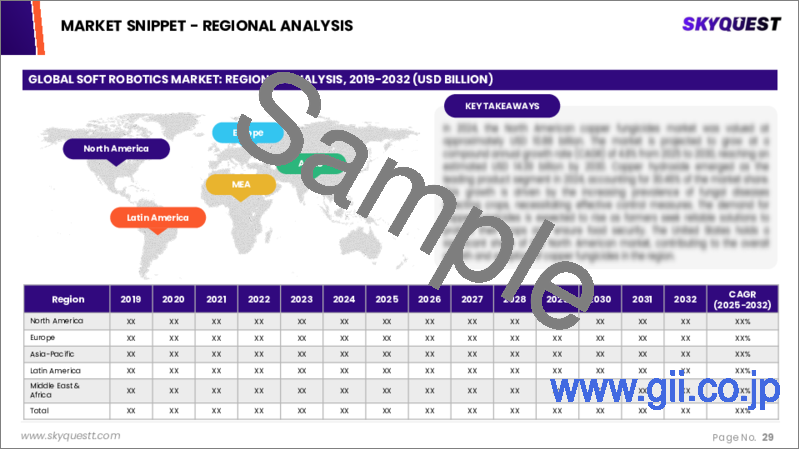|
|
市場調査レポート
商品コード
1629051
ソフトロボットの市場規模、シェア、成長分析、タイプ別、コンポーネント別、素材別、用途別、地域別 - 産業予測、2025-2032年Soft Robotics Market Size, Share, Growth Analysis, By Type (Soft Grippers, Inflatable Robots), By Component (Soft Actuators, Soft Sensors), By Material, By Application, By Region - Industry Forecast 2025-2032 |
||||||
|
|||||||
| ソフトロボットの市場規模、シェア、成長分析、タイプ別、コンポーネント別、素材別、用途別、地域別 - 産業予測、2025-2032年 |
|
出版日: 2025年01月08日
発行: SkyQuest
ページ情報: 英文 235 Pages
納期: 3~5営業日
|
全表示
- 概要
- 目次
ソフトロボットの世界市場規模は2023年に14億5,000万米ドルと評価され、2024年の18億8,000万米ドルから2032年には151億6,000万米ドルに成長し、予測期間(2025-2032年)のCAGRは29.8%で成長する見通しです。
ソフトロボット分野は、従来の硬い素材の代わりに柔軟な素材を使用することを特徴としており、人間とロボットの相互作用を強化する需要の高まりと、さまざまな産業での幅広い採用により、大きな成長が見込まれています。ロボット工学と材料技術の革新は、ソフトロボット市場の将来の軌道を形成する上で極めて重要です。急速な都市化と工業化の動向は、多様な分野での自動化の進展とともに、ソフトロボットプロバイダーにとって有望な情勢を提示しています。特にヘルスケア産業は、今後数年間で主要な応用分野となることが予想されます。しかし、耐久性の限界や製造の難しさといった課題が、長期的な市場開拓の妨げになる可能性があります。全体として、ソフトロボットは進化を続けており、見通しは楽観的です。
目次
イントロダクション
- 調査の目的
- 調査範囲
- 定義
調査手法
- 情報調達
- 二次データと一次データの方法
- 市場規模予測
- 市場の前提条件と制限
エグゼクティブサマリー
- 世界市場の見通し
- 供給と需要の動向分析
- セグメント別機会分析
市場力学と見通し
- 市場概要
- 市場規模
- 市場力学
- 促進要因と機会
- 抑制要因と課題
- ポーターの分析
主な市場の考察
- 重要成功要因
- 競合の程度
- 主な投資機会
- 市場エコシステム
- 市場の魅力指数(2024年)
- PESTEL分析
- マクロ経済指標
- バリューチェーン分析
- 価格分析
- 技術分析
- 規制分析
- 特許分析
- ケーススタディ分析
ソフトロボット市場規模:タイプ別& CAGR(2025-2032)
- 市場概要
- ソフトグリッパー
- インフレータブルロボット
- 外骨格
- ウェアラブル
- その他
ソフトロボット市場規模:コンポーネント別& CAGR(2025-2032)
- 市場概要
- ソフトアクチュエータ
- ソフトセンサー
- 制御システム
- 電源
- その他
ソフトロボット市場規模:素材別& CAGR(2025-2032)
- 市場概要
- エラストマー
- ジェル
- 生地
- その他
ソフトロボット市場規模:用途別& CAGR(2025-2032)
- 市場概要
- 医療とヘルスケア
- リハビリテーション
- 手術
- 補助器具
- 飲食品
- 食品の取り扱い
- パッケージ
- ロジスティクス
- 倉庫保管
- マテリアルハンドリング
- 自動車
- 製造業
- 組み立て
- 農業
- 収穫
- 植付
- その他
ソフトロボット市場規模& CAGR(2025-2032)
- 北米
- 米国
- カナダ
- 欧州
- ドイツ
- スペイン
- フランス
- 英国
- イタリア
- その他欧州地域
- アジア太平洋地域
- 中国
- インド
- 日本
- 韓国
- その他アジア太平洋地域
- ラテンアメリカ
- ブラジル
- その他ラテンアメリカ地域
- 中東・アフリカ
- GCC諸国
- 南アフリカ
- その他中東・アフリカ
競合情報
- 上位5社の比較
- 主要企業の市場ポジショニング(2024年)
- 主な市場企業が採用した戦略
- 市場の最近の動向
- 企業の市場シェア分析(2024年)
- 主要企業の企業プロファイル
- 会社概要
- 製品ポートフォリオ分析
- セグメント別シェア分析
- 収益の前年比比較(2022-2024)
主要企業プロファイル
- Soft Robotics Inc.(US)
- Festo AG(Germany)
- Ekso Bionics Holdings, Inc.(US)
- ReWalk Robotics(US)
- Yaskawa Electric Corporation(Japan)
- ABB Group(Switzerland)
- Kawada Robotics(Japan)
- Techman Robot Inc.(Taiwan)
- Bionik Laboratories Corp.(Canada)
- Righthand Robotics(US)
- Fanuc Corporation(Japan)
- Universal Robots(Denmark)
- Cyberdyne Inc.(Japan)
- SRT(US)
- Pneubotics(US)
- Applied Robotics(US)
- Robot System Products AB(Sweden)
- Shadow Robot Company(UK)
- Omron Corporation(Japan)
- Siemens AG(Germany)
結論と推奨事項
Global Soft Robotics Market size was valued at USD 1.45 billion in 2023 and is poised to grow from USD 1.88 billion in 2024 to USD 15.16 billion by 2032, growing at a CAGR of 29.8% during the forecast period (2025-2032).
The soft robotics sector, characterized by the use of flexible materials instead of traditional rigid ones, is poised for significant growth due to increasing demand for enhanced human-robot interactions and wider adoption across various industries. Innovations in robotics and materials technology will be crucial in shaping the future trajectory of the soft robotics market. The ongoing trends of rapid urbanization and industrialization, along with the growing automation across diverse sectors, present a promising landscape for soft robotics providers. Specifically, the healthcare industry is expected to be a major application area in the coming years. However, challenges such as limited durability and manufacturing difficulties may hinder long-term market development. Overall, the outlook for soft robotics remains optimistic as it continues to evolve.
Top-down and bottom-up approaches were used to estimate and validate the size of the Global Soft Robotics market and to estimate the size of various other dependent submarkets. The research methodology used to estimate the market size includes the following details: The key players in the market were identified through secondary research, and their market shares in the respective regions were determined through primary and secondary research. This entire procedure includes the study of the annual and financial reports of the top market players and extensive interviews for key insights from industry leaders such as CEOs, VPs, directors, and marketing executives. All percentage shares split, and breakdowns were determined using secondary sources and verified through Primary sources. All possible parameters that affect the markets covered in this research study have been accounted for, viewed in extensive detail, verified through primary research, and analyzed to get the final quantitative and qualitative data.
Global Soft Robotics Market Segmental Analysis
Global Soft Robotics Market is segmented by Type, Component, Material, Application and region. Based on Type, the market is segmented into Soft Grippers, Inflatable Robots, Exoskeletons, Wearables and Others. Based on Component, the market is segmented into Soft Actuators, Soft Sensors, Control Systems, Power Sources and Others. Based on Material, the market is segmented into Elastomers, Gels, Fabrics and Others. Based on Application, the market is segmented into Medical and Healthcare, Food & Beverage, Logistics, Automotive, Agriculture and Others. Based on region, the market is segmented into North America, Europe, Asia Pacific, Latin America and Middle East & Africa.
Driver of the Global Soft Robotics Market
The global soft robotics market is significantly driven by the continuous innovation within the robotics sector. Recent advancements and increased investments in research and development have propelled the appeal of soft robotics, making it a sought-after solution across various industries. These innovations facilitate the creation of more adaptable, flexible, and safer robotic systems, capable of working alongside humans and navigating complex environments. As organizations increasingly recognize the potential benefits that these cutting-edge technologies offer, the demand for soft robotics continues to rise, thereby fueling growth and expansion in this dynamic market.
Restraints in the Global Soft Robotics Market
The global soft robotics market faces significant hurdles, particularly in manufacturing processes. The production of soft robotics on a large scale presents substantial challenges due to the advanced and commercially unviable equipment necessary for this technology. These constraints in manufacturing capabilities hinder the overall growth potential of the soft robotics market, creating obstacles for widespread adoption and innovation. As manufacturers struggle to implement the required technologies efficiently, the market's expansion is effectively stunted, limiting the ability to meet growing demand and explore new applications for soft robotics in various industries. Thus, addressing these manufacturing challenges is crucial for future market success.
Market Trends of the Global Soft Robotics Market
The global soft robotics market is experiencing a significant trend towards biomimicry, where companies are increasingly focused on emulating human biology and behaviors in their designs. This shift enhances the versatility and applicability of soft robotic systems across various industries, from healthcare to manufacturing. By integrating biomaterials into their innovations, firms can achieve improved flexibility and adaptability, making their products more human-like and efficient. As the demand for intuitive and responsive robotic solutions grows, emphasizing biomimicry not only aligns with market needs but also drives competitive differentiation, positioning companies for success in an evolving technological landscape.
Table of Contents
Introduction
- Objectives of the Study
- Scope of the Report
- Definitions
Research Methodology
- Information Procurement
- Secondary & Primary Data Methods
- Market Size Estimation
- Market Assumptions & Limitations
Executive Summary
- Global Market Outlook
- Supply & Demand Trend Analysis
- Segmental Opportunity Analysis
Market Dynamics & Outlook
- Market Overview
- Market Size
- Market Dynamics
- Drivers & Opportunities
- Restraints & Challenges
- Porters Analysis
- Competitive rivalry
- Threat of substitute
- Bargaining power of buyers
- Threat of new entrants
- Bargaining power of suppliers
Key Market Insights
- Key Success Factors
- Degree of Competition
- Top Investment Pockets
- Market Ecosystem
- Market Attractiveness Index, 2024
- PESTEL Analysis
- Macro-Economic Indicators
- Value Chain Analysis
- Pricing Analysis
- Technology Analysis
- Regulatory Analysis
- Patent Analysis
- Case Study Analysis
Global Soft Robotics Market Size by Type & CAGR (2025-2032)
- Market Overview
- Soft Grippers
- Inflatable Robots
- Exoskeletons
- Wearables
- Others
Global Soft Robotics Market Size by Component & CAGR (2025-2032)
- Market Overview
- Soft Actuators
- Soft Sensors
- Control Systems
- Power Sources
- Others
Global Soft Robotics Market Size by Material & CAGR (2025-2032)
- Market Overview
- Elastomers
- Gels
- Fabrics
- Others
Global Soft Robotics Market Size by Application & CAGR (2025-2032)
- Market Overview
- Medical and Healthcare
- Rehabilitation
- Surgery
- Assistive Devices
- Food & Beverage
- Food Handling
- Packaging
- Logistics
- Warehousing
- Material Handling
- Automotive
- Manufacturing
- Assembly
- Agriculture
- Harvesting
- Planting
- Others
Global Soft Robotics Market Size & CAGR (2025-2032)
- North America (Type, Component, Material, Application)
- US
- Canada
- Europe (Type, Component, Material, Application)
- Germany
- Spain
- France
- UK
- Italy
- Rest of Europe
- Asia Pacific (Type, Component, Material, Application)
- China
- India
- Japan
- South Korea
- Rest of Asia-Pacific
- Latin America (Type, Component, Material, Application)
- Brazil
- Rest of Latin America
- Middle East & Africa (Type, Component, Material, Application)
- GCC Countries
- South Africa
- Rest of Middle East & Africa
Competitive Intelligence
- Top 5 Player Comparison
- Market Positioning of Key Players, 2024
- Strategies Adopted by Key Market Players
- Recent Developments in the Market
- Company Market Share Analysis, 2024
- Company Profiles of All Key Players
- Company Details
- Product Portfolio Analysis
- Company's Segmental Share Analysis
- Revenue Y-O-Y Comparison (2022-2024)
Key Company Profiles
- Soft Robotics Inc. (US)
- Company Overview
- Business Segment Overview
- Financial Updates
- Key Developments
- Festo AG (Germany)
- Company Overview
- Business Segment Overview
- Financial Updates
- Key Developments
- Ekso Bionics Holdings, Inc. (US)
- Company Overview
- Business Segment Overview
- Financial Updates
- Key Developments
- ReWalk Robotics (US)
- Company Overview
- Business Segment Overview
- Financial Updates
- Key Developments
- Yaskawa Electric Corporation (Japan)
- Company Overview
- Business Segment Overview
- Financial Updates
- Key Developments
- ABB Group (Switzerland)
- Company Overview
- Business Segment Overview
- Financial Updates
- Key Developments
- Kawada Robotics (Japan)
- Company Overview
- Business Segment Overview
- Financial Updates
- Key Developments
- Techman Robot Inc. (Taiwan)
- Company Overview
- Business Segment Overview
- Financial Updates
- Key Developments
- Bionik Laboratories Corp. (Canada)
- Company Overview
- Business Segment Overview
- Financial Updates
- Key Developments
- Righthand Robotics (US)
- Company Overview
- Business Segment Overview
- Financial Updates
- Key Developments
- Fanuc Corporation (Japan)
- Company Overview
- Business Segment Overview
- Financial Updates
- Key Developments
- Universal Robots (Denmark)
- Company Overview
- Business Segment Overview
- Financial Updates
- Key Developments
- Cyberdyne Inc. (Japan)
- Company Overview
- Business Segment Overview
- Financial Updates
- Key Developments
- SRT (US)
- Company Overview
- Business Segment Overview
- Financial Updates
- Key Developments
- Pneubotics (US)
- Company Overview
- Business Segment Overview
- Financial Updates
- Key Developments
- Applied Robotics (US)
- Company Overview
- Business Segment Overview
- Financial Updates
- Key Developments
- Robot System Products AB (Sweden)
- Company Overview
- Business Segment Overview
- Financial Updates
- Key Developments
- Shadow Robot Company (UK)
- Company Overview
- Business Segment Overview
- Financial Updates
- Key Developments
- Omron Corporation (Japan)
- Company Overview
- Business Segment Overview
- Financial Updates
- Key Developments
- Siemens AG (Germany)
- Company Overview
- Business Segment Overview
- Financial Updates
- Key Developments






